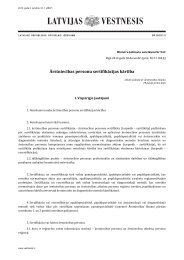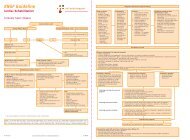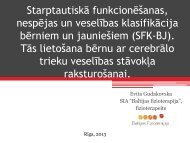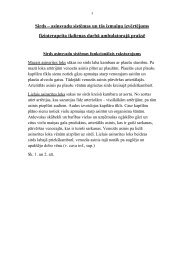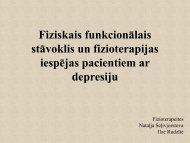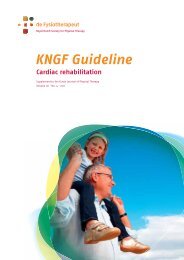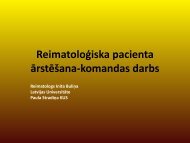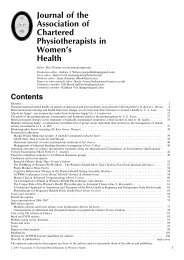You also want an ePaper? Increase the reach of your titles
YUMPU automatically turns print PDFs into web optimized ePapers that Google loves.
<strong>Low</strong> <strong>Back</strong> <strong>Pain</strong>: Clinical Practice Guidelines<br />
use as a psychological assessment tool; therefore, pain drawings<br />
are not recommended for this purpose. 42<br />
Though some individual and lifestyle variables<br />
have been associated with prevalence of low back<br />
pain, the same factors may not have an influence<br />
on the recovery of patients who already have back pain. For<br />
example, a previous history of low back pain, job satisfaction,<br />
educational level, marital status, number of dependents,<br />
smoking, working more than 8-hour shifts, occupation, and<br />
size of industry or company does not influence duration of<br />
sick leave due to low back pain. 282 In addition, the clinical<br />
course for patients with comorbidities, who may seem more<br />
complicated at the start of treatment, is just as favorable as<br />
for those without such comorbidities. 213 Consistent evidence<br />
was found for one's own expectations of recovery as a predictor<br />
for the decision to return to work. Patients with higher<br />
expectations had less sickness absence at the moment of follow-up<br />
measurement. 188 Consistent evidence was found for<br />
the predictive value of pain intensity (more pain associated<br />
with worse outcome), several work-related parameters (eg,<br />
high satisfaction associated with better outcome), and coping<br />
style (active coping associated with better outcome). 297<br />
II<br />
In adolescents, the overall risk of low back pain is<br />
similar to adults, with prevalence rates as high as<br />
70% to 80% by 20 years of age. 170 Similar to adults,<br />
girls appear to have a higher prevalence, with 1 study demonstrating<br />
that females have almost 3 times the risk of back pain<br />
as their male counterparts. 300 Anthropometrics (eg, height,<br />
weight, body mass index) do not appear to be strongly associated<br />
with low back pain in adolescents, nor does lumbar<br />
mobility189 or trunk muscle weakness. 15 In adolescents,<br />
lifestyle factors that have been studied with respect to risk<br />
for low back pain include physical activity, sedentary activity,<br />
and mechanical load. With regard to physical activity, there<br />
appear to be mixed findings, with certain activities related<br />
to specific sports (eg, weightlifting, body building, rowing)<br />
associated with low back pain. 90,145,214 In cross-sectional studies,<br />
activity and prevalence of back pain take on a U-shaped<br />
function, with back pain increased at the sedentary and<br />
higher-activity ends. 290,311 However, in longitudinal studies,<br />
the relationship between modifying physical activity and<br />
back pain prevalence has not been well established. 172,261 As<br />
is the case in adults, psychological and psychosocial factors<br />
are commonly increased in children with low back pain and<br />
there is some evidence that such factors can predict future<br />
onset of low back pain. 171-173,311<br />
II<br />
Current literature does not support a definitive<br />
B cause for initial episodes of low back pain. Risk factors<br />
are multifactorial, population specific, and only<br />
weakly associated with the development of low back pain.<br />
a12 | april 2012 | volume 42 | number 4 | journal of orthopaedic & sports physical therapy<br />
PATHOANATOMICAL FEATURES<br />
Any innervated structure in the lumbar spine can cause<br />
symptoms of low back and referred pain into the extremity<br />
or extremities. This long list of potential structures includes<br />
the muscles, ligaments, dura mater and nerve roots,<br />
zygapophyseal joints, annulus fibrosis, thoracolumbar fascia,<br />
and vertebrae. 177,178,192 One might expect that improvement in<br />
the resolution of imaging technology has increased the likelihood<br />
of detecting a link between pathology and pain in the<br />
lumbar spine. However, the determination of a pathoanatomic<br />
origin of low back pain is made difficult by the rate of<br />
false-positive findings on imaging studies, that is, individuals<br />
without low back pain showing abnormal findings. For example,<br />
evidence of herniated disc material is shown on computerized<br />
tomography (CT) scans, 319 MRI, 31 and myelography 161<br />
in 20% to 76% of persons with no sciatica. Furthermore, Savage<br />
et al 264 reported that 32% of their asymptomatic subjects<br />
had “abnormal” lumbar spines (evidence of disc degeneration,<br />
disc bulging or protrusion, facet hypertrophy, or nerve<br />
root compression) and only 47% of their subjects who were<br />
experiencing low back pain had an abnormality identified.<br />
In longitudinal studies, low back pain can develop in the absence<br />
of any associated change in radiographic appearance of<br />
the spine. 264 Boos et al 33 followed asymptomatic patients with<br />
a herniated disc for 5 years and determined that physical job<br />
characteristics and psychological aspects of work were more<br />
powerful than MRI-identified disc abnormalities in predicting<br />
the need for low back pain–related medical consultation.<br />
Thus, the association between clinical complaints and concurrent<br />
pathological examination with radiological findings<br />
must be considered cautiously. Further, even when abnormalities<br />
are present, establishing a direct cause and effect<br />
between the pathological finding and the patient condition<br />
has proven to be elusive and most often does not assist greatly<br />
in patient management.<br />
CLINICAL COURSE<br />
Classically, the course of low back pain has been described<br />
to consist of acute, subacute, and chronic phases, with temporal<br />
definitions typically associated with each phase. While<br />
different operational definitions have been reported in the<br />
literature, commonly accepted definitions for the acute, subacute,<br />
and chronic phases are, respectively, less than 1 month,<br />
between 2 and 3 months, and greater than 3 months since the<br />
onset of the episode of low back pain.<br />
Because low back pain is often recurrent in nature,<br />
exclusive use of temporal definitions to describe its<br />
course has been challenged in the literature. 302,304<br />
II<br />
The primary argument is that when low back pain is recurrent,<br />
the time to improvement from a single episode does not



